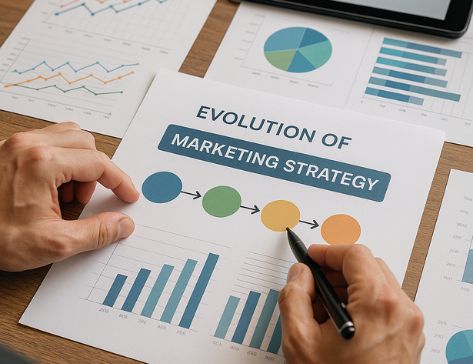
The Evolution of Marketing Strategy: Frameworks, Steps, and Tools for 2025
The evolution of marketing strategy continues to accelerate as channels, data, and customer expectations shift faster than most teams can plan. From mass media to social commerce to AI copilots, the discipline has transformed from a campaign-centric function into an operating system for growth—spanning market research, product positioning, lifecycle orchestration, analytics, and continuous experimentation.
To orient ourselves, it helps to look at how the craft matured: from the print era and broadcast reach, to CRM-driven personalization, and finally to an omnichannel, data-rich digital age defined by real-time feedback loops. Each wave reshaped how we segment audiences, form value propositions, and allocate budget—yet enduring truths remain: know your customer deeply, speak to their jobs-to-be-done, and measure outcomes that tie to business value.

A Brief Timeline of Strategy Shifts
Marketing’s journey mirrors the technology curve. In the late 20th century, reach and frequency dominated. The 2000s brought search, performance marketing, and content as compounding assets. The 2010s layered mobile, marketing automation, and cross-channel attribution. The 2020s added privacy shifts, first-party data, and AI-assisted creativity and analysis. The result is a hybrid playbook: narrative-led brand building paired with rigorous, iterative growth practices.
Data, AI, and Marketing Intelligence
Today’s differentiator is how effectively teams translate signals into decisions. Robust first-party data, event instrumentation, and experimentation infrastructure turn insights into impact. For a deeper dive, see resources on the role of data in marketing intelligence, which outline how to operationalize predictive models, propensity scoring, and incrementality testing without losing sight of customer empathy.
A Step-by-Step Framework to Modern Marketing Strategy
- Clarify business outcomes. Anchor your strategy to a small set of measurable north stars (e.g., qualified pipeline, activation rate, 6‑month LTV, retention, NPS). Write them as equations and ensure they’re visible to the team.
- Define the ICP and personas through evidence. Use qualitative interviews, win/loss analysis, and usage telemetry to map pains, triggers, and buying committees. Summarize in a one-page brief per persona.
- Craft a crisp positioning narrative. Complete sentences like: “For [ICP] who struggle with [pain], our product is a [category] that delivers [primary benefit], unlike [main alternative].” Socialize it across marketing, product, and sales.
- Map the lifecycle and jobs-to-be-done. Outline awareness → consideration → evaluation → purchase → onboarding → adoption → expansion → advocacy. Identify the 2–3 critical behaviors that predict success at each stage.
- Design channel strategy across owned, earned, and paid. Sequence channels based on readiness and cost curves. Start with compounding assets (SEO, email, product-led loops), then layer experiments in paid and partnerships.
- Build the measurement plan. Define input metrics (lead quality, CTR, engagement), output metrics (pipeline, revenue, LTV), and diagnostic metrics (holdout lift, time-to-value). Decide what gets weekly, monthly, and quarterly reviews.
- Operationalize experiments. Maintain a prioritized backlog. For each test, write a hypothesis, expected impact, success criteria, and a debrief template. Close the loop by codifying learnings into playbooks.
- Resource and enable the team. Assign clear DRIs, establish a content calendar, and automate workflows where possible. Align with sales and product to ensure message-market-channel fit.
Core Principles That Endure
- Customer-first clarity: The most efficient tactic is empathy. Messaging rooted in customer language outperforms cleverness.
- Compounding beats one-offs: Content, community, SEO, and product loops increase marginal returns over time.
- Sequencing matters: Great tactics executed in the wrong order still fail. Solve for the biggest constraint first.
- Measure what matters: Tie proxies (clicks, MQLs) to business outcomes (revenue, retention) to avoid vanity cycles.
- Document, then automate: Standardize playbooks before tooling; otherwise, you’ll automate chaos.
Channel Strategy: Owned, Earned, and Paid
Owned
Your website, product, email, and community channels are durable assets. Strong information architecture, fast performance, and helpful content align SEO with conversion. Email and lifecycle messaging should be value-heavy and behavior-triggered (e.g., onboarding milestones, usage tips, expansion prompts).
Earned
PR, reviews, analyst relations, and community advocacy create credibility you can’t buy. Social proof—customer stories, G2 reviews, case studies, influencer mentions—lowers perceived risk. Treat customers as collaborators, not just references.
Paid
Paid media accelerates learning when used to test messaging and audiences, not just to buy traffic. Protect budgets with structured experiments, creative refresh cadences, negative keyword lists, and frequency caps. Focus on post-click experience and downstream quality, not only CPC.
Practical Tips for Execution
- Write strategy in public: Maintain a living strategy doc and share a monthly loom/walkthrough across GTM and product.
- Start a “message lab”: Test headlines and offers in low-cost channels before committing to a quarter-long campaign.
- Create a content operating model: Establish pillars → clusters → briefs → production → distribution → refresh schedule.
- Systematize SEO: Align topics to intent, use content outlines, add internal links, and schedule refreshes for decaying pages.
- Instrument onboarding: Set event tracking for aha moments, habit milestones, and friction points to drive in-product nudges.
- Close the loop with sales: Weekly review call: what messaging resonated, what objections surfaced, what assets are missing?
- Guardrail metrics: Track CAC payback, contribution margin, and channel saturation to avoid growth that destroys unit economics.
Measurement and Iteration
Pick a cadence and stick to it. Weekly: pulse of experiments and channel health. Monthly: performance deep dive, content refresh planning, budget rebalancing. Quarterly: strategic bet reviews, capability gaps, and roadmap pruning. Use control groups and holdouts to quantify true lift, and favor directional momentum over false precision when data is sparse.
Common Pitfalls (and How to Avoid Them)
- Strategy by tactic: Jumping into ads or events without a narrative and ICP fit wastes time. Start with positioning.
- Measuring too much, learning too little: Dashboards aren’t insights. Summarize learnings into decisions and next steps.
- Over-personalization: Granular segments with thin creative pipelines degrade quality. Personalize where value changes.
- Channel overreliance: Algorithms change. Diversify and invest in compounding owned assets.
- Skipping refresh cycles: Content and creative decay. Schedule updates before performance slumps.
Conclusion
The evolution of marketing strategy is ultimately a story about learning speed and customer obsession. Teams that ground their plans in genuine insight, iterate with discipline, and invest in compounding assets will outpace those chasing the tactic of the week. As you refine your playbook—especially in paid and competitor research—consider modern competitive intelligence tools, but pair them with a strong brand narrative, a robust measurement plan, and a cadence that turns data into better decisions. The future belongs to marketers who can connect empathy with evidence—and do it consistently.


